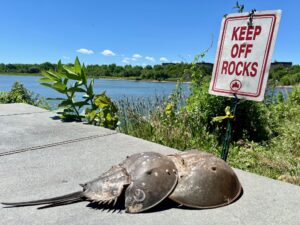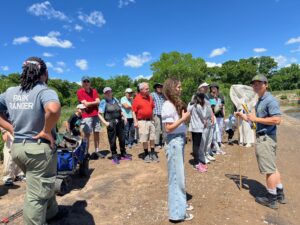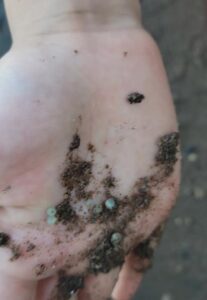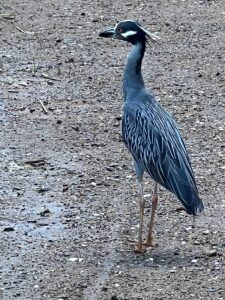Parks Department Urban Rangers treated visitors to a close examination of the horseshoe crab and tour of their spawning grounds at a “Wildlife Viewing: Horseshoe Crabs” event held at the Salt Marsh Nature Center at 3302 Avenue U on Saturday, June 8th.
Urban Park Rangers Li Jiang and Kendall James met with the group behind the Center where they talked about the anatomy, mating habits and other interesting information about the horseshoe crab.
“We were lucky to be able to find a dead one that still had a lot of parts intact so you can look up close,” Jiang said. “You can go even closer and get a good smell,” he added, which elicited laughter and some people backing away from the dead body he was holding up for them to view.
The Atlantic Horseshoe Crab has been around for over 400 million years, giving it the reputation of being a “living fossil.” They appear in May and June, coming up on the shore during a full moon or high tide to lay large amounts of eggs, which provide food for migratory birds.
“Each cluster of eggs contains about 4,000 eggs and at night, some of them lay over 20,000 eggs,” Jiang said.
They are considered arthropods, which makes them more closely related to spiders, scorpions and other crustaceans like lobsters and crabs.
James spoke about the chemical in the horseshoe crab’s blood, which has an unusual blue color due to its copper content. “Usually when copper oxidizes, when it starts to mix with oxygen, it turns blue,” he said.
“[The horseshoe crab is] famous for its blue blood and for helping us make vaccines,” Jiang added, noting that there is a chemical in their blood that helps detect toxins in vaccines.
The group then proceeded to walk toward the entrance to the beach at the corner of Avenue U and Burnett Street. Evidence of horseshoe crab eggs were found in the sand. Jiang said that they usually come up at dusk or at night to lay their eggs.
Although they didn’t see any live horseshoe crabs at that time of the day, there were plenty of other sightings of fiddler crabs, mussels, a moon jellyfish, a yellow-crowned night heron and other shorebirds during a pleasant walk along the beach.









